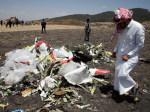REUTERS/Tiksa Negeri
- Investigators are currently pouring over black box data to figure what caused Ethiopian Airlines Flight ET302 to crash last week.
- The cause of the is yet unknown.
- According to IATA Safety Report 2017, the most common contributing factor was flight crew error.
- Plane crashes are rarely caused by a single factor, but a series of contributing factors.
Ethiopian Airlines Flight ET302 crashed last week, killing all 157 passengers and crew on board the Boeing 737 Max 8 jetliner. Investigators are currently digging through data from the doomed plane's black boxes to determine the cause of the crash.
Even though Boeing's controversial MCAS control system has been mentioned as something that may have contributed to the crash, the ultimate cause of the deadly incident has not been determined.
This led us to ask the question, what can cause a plane to crash?
The International Air Transport Association recorded 340 accidents between 2013 and 2017. Of which, 68% resulted in substantial damage and 13% were fatal.
According to IATA Safety Report 2017, the most common contributing factor was flight crew error. The operative word here being "contributing."
Plane crashes are rarely caused by a single factor, instead, they're usually caused by the culmination of a series contributing factors, aviation safety consultant Keith Mackey told Business Insider in an interview.
Mark Millam, vice president of technical at the Flight Safety Foundation, echoed those sentiments.
Millam, who has three decades worth of experience in the airline industry, cited the Swiss Cheese model of accident causation as an easy way to think about how aviation safety works.
The Swiss Cheese model, which was originally attributed to Prof. James Reason at the University of Manchester, says aviation safety systems are like layers of swiss cheese that are filled with holes.
Issues that make it past one layer of defense is usually cut off by the next. However, sometimes those holes line up and that's when the system fails and accidents happen.
As an example, Mackey brought up the causes of the crash of Air France Flight 447 in 2009. On June 1, 2009, the Airbus A330 en route from Rio de Janeiro, Brazil to Paris, stalled and crashed into the Atlantic Ocean killing all 228 on board.
French investigators didn't list one cause in its accident report, but a series of contributing causes that escalated the situation. First, ice crystals obstructed the plane's pitot tubes that resulted in a loss of airspeed readings followed by the crew's incorrect reaction to the malfunction, poor situational, management, and inadequate training.
"Had the instrument system not had the problem, the fact pilots were unable to handle the problem would not have ever had the chance to pass and the aircraft would have landed normally in Paris," Mackey, a former Pan Am flight instructor and Boeing 747 captain said. "It took two things, it took something wrong and then someone not knowing how to deal with what was wrong."
NOW WATCH: Meet the guy who wraps celebrities' supercars, including Harry Styles and KSI
See Also:
- Trump announces all Boeing 737 Max jets are immediately grounded following its 2nd crash in 5 months
- Here's how much Boeing is estimated to make on each 737 Max 8 plane
- This map shows all the countries to ban the Boeing 737 Max 8, and where airlines have grounded their fleets, after Ethiopian Airlines crash that killed 157
FOLLOW US: On Facebook for more car and transportation content!
